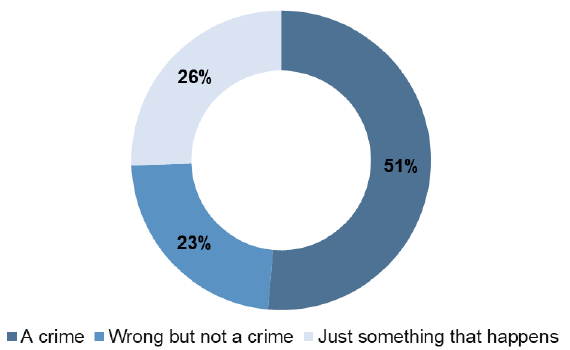Non-sexual violence in Scotland: report
Findings on the most up to date, complementary statistics on non-sexual violence in Scotland.
This document is part of a collection
7 What do we know about unreported violence?
Key Findings:
The SCJS provides estimates for measuring the proportion of crime reported to the police in Scotland.
The 2017-18 SCJS estimates that the majority (61%) of violent incidents in 2017-18 were not reported to the police, similar to the reporting rate in previous years.
Police Recorded Crime data provides figures on crime which has been reported to the police, however it is unable to provide an estimate of the level of unreported crime. As outlined in Section 1.3, the SCJS asks adults about their experiences of crime regardless of whether or not it was reported, and therefore provides the best estimate of overall levels of violence experienced in Scotland as well as the amount (and proportion) of crime which has not been brought to the attention of the police.
Scottish Crime and Justice Survey
The SCJS asks respondents who report experience of violent crime if the police came to know about the matter. The 2017-18 SCJS estimates that just under two-fifths of violent incidents (39%) were brought to the attention of the police. The reporting rate in 2017-18 was not significantly different from the rate in any SCJS sweep since 2008-09 (for example, 43% in both 2008-09 and 2016-17).
There can be a range of factors which influence whether or not an individual reports a crime to the police, not least how the victim views their own experience. For instance, the SCJS finds that in around half of violent incidents in 2017-18 (51%) victims thought their experience should be described as ‘a crime’ as shown in Figure 19 below. Just over three-fifths (62%) of incidents which victims considered to be a crime were brought to the attention of the police in 2017-18.
Figure 19: Victim's description of violent crime incidents experienced.

Base: Violent crime incidents (120); Variable: QCRNO
Source: Scottish Crime and Justice Survey, 2017-18
When asked directly why they did not report their experience, regardless of whether they viewed their experience as a crime or not, victims cited a range of reasons. The most common explanations provided by victims were that:
- they reported the matter to other authorities (35% of unreported violent crime);
- they dealt with the matter themselves (19%);
- the issue was considered a private, personal or family matter (13%);
- the experience was too trivial or not worth reporting (11%).
- ‘other’ reasons were cited in 24% of cases.
Comparing these figures to previous results, there appears to be some changes over time, however some of this variablitly may be caused by small sample sizes. In previous years, the police not being interested or being unable to do anything were also amongst the most common reasons for not reporting violent incidents to the police.
When looking only at cases of violent crime where the police did not know about the matter, the sample size is reduced considerably[41]. Therefore, it is difficult to produce meaningful analysis from these results and further analysis from any single year of survey data is limited.
In future, combining the SCJS surveys since 2008-09 into one dataset will create a bigger sample size and allow for more detailed analysis of unreported violence, in terms of the characteristics of those experiencing unreported crime; the types of crimes most likely to not be reported to the police; and potential differences in the characteristics and impact of reported and unreported violent crime.
Contact
Email: Frances.warren@gov.scot
There is a problem
Thanks for your feedback